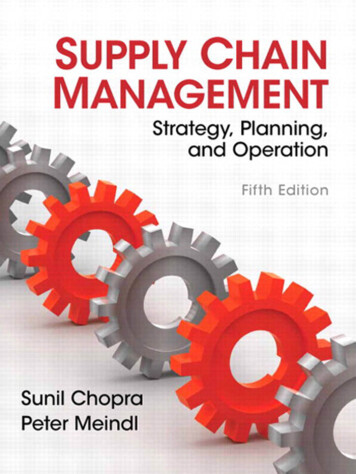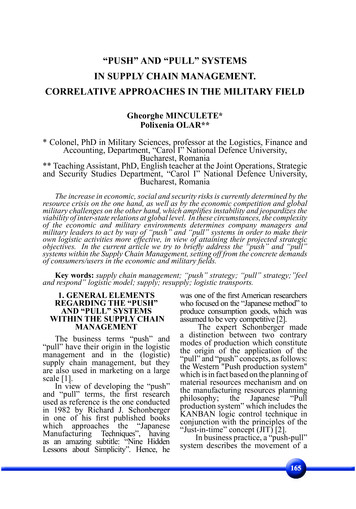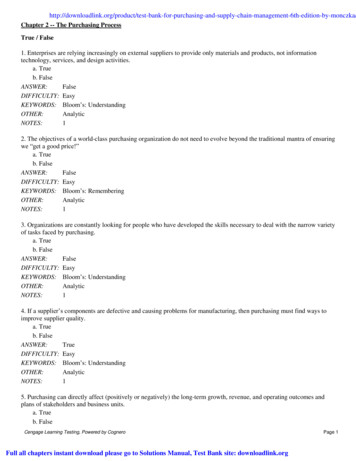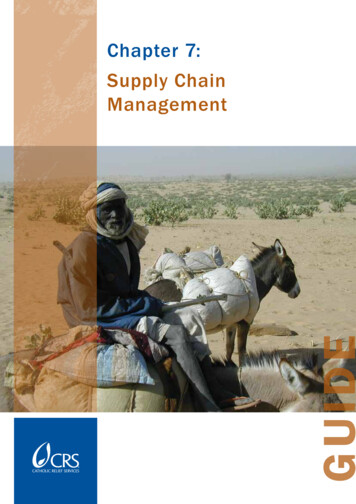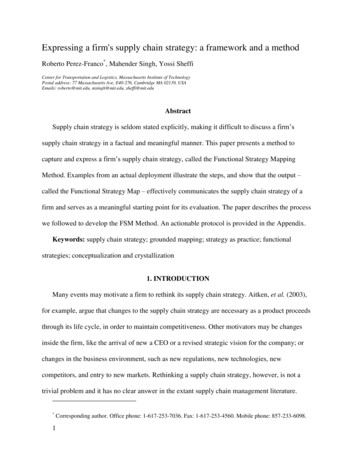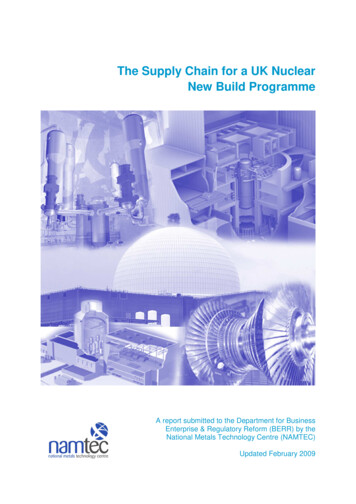
Transcription
The Supply Chain for a UK NuclearNew Build ProgrammeA report submitted to the Department for BusinessEnterprise & Regulatory Reform (BERR) by theNational Metals Technology Centre (NAMTEC)Updated February 2009
The Supply Chain for a UK Nuclear New Build ProgrammeAuthorDr. Stephen A. Court, the National Metals Technology Centre (NAMTEC)Updated version of a report submitted to the Department for BusinessEnterprise & Regulatory Reform (BERR) by the National MetalsTechnology Centre (NAMTEC), and published on 8th September 2008.Care has been taken to ensure that the content of this report is accurate, butNAMTEC does not accept responsibility for errors, omissions or for subsequent useof this information.For further information or assistance, please contact:Dr. Stephen A. CourtThe National Metals Technology Centre (NAMTEC)Swinden HouseMoorgate RoadRotherham S60 3ARTel:01709 722465Mobile: 07834 334150Email: stephen.court@namtec.co.ukAcknowledgementsThe author would like to acknowledge the contributions to the report of individualsfrom: The Department of Business Enterprise & Regulatory Reform (BERR), TheNuclear Industry Association (NIA) and UK Trade and Investment (UKTI). In addition,input from the reactor vendors (AREVA, Westinghouse Electric Company and GEHitachi), AMEC, BAE Systems, British Energy, Costain, Doosan Babcock, EDFEnergy, Parsons Brinckerhoff, Rolls-Royce, Serco, Sheffield Forgemasters and SirRobert McAlpine is gratefully acknowledged.Furthermore, the author would like to acknowledge the support of Mike Sugden ofBERR’s Nuclear Unit (now the Office for Nuclear Development (OND), within theDepartment of Energy and Climate Change (DECC)) during the preparation of thisreport.Page 2
The Supply Chain for a UK Nuclear New Build ProgrammeExecutive SummaryAimsThis report gives a brief summary of information available regarding both the capability and capacity ofthe supply chain(s) relevant to a UK new civil nuclear build programme, including aspects of theplanning, construction, operation, maintenance, waste management, and decommissioning of a nuclearpower station or nuclear industry.In addition, the report indicates: (a) where some of the more valuable elements of the supply chain maylie, for both a UK nuclear new build programme and for opportunities for export, and (b) the potentialissues within the supply chain, both UK-based and global, which may threaten a UK new buildprogramme.Thus, the major aims of the work may be summarised as follows: To identify the scope (capability & capacity) of the nuclear supply chain;To give an initial view of where the UK has expertise and/or the potential to compete for UKnuclear new build and in overseas nuclear builds;To give a preliminary, qualitative assessment of some of the most valuable elements of thesupply chain (ie, to identify the value chain); andTo give a brief view of the critical points (gaps or ‘pinch-points’) within the supply chain, bothUK based and global, which could threaten a UK new build programme.The work forms part of a significantly larger, and more detailed ongoing activity aimed at identifying: Where the UK has either existing expertise and resources, or potential opportunity, to feed intoa nuclear new build programme;The value chain in a nuclear new build programme – ie, what is the value of each element ofthe supply chain, in a rank order of what adds most value;Where and how UK-based companies can best obtain market share in a UK nuclear new buildprogramme ?;Which aspects of a nuclear new build programme will provide the best UK / community benefitthrough, for example, the creation of incremental skills and high value, sustainable jobs basedwithin the UK ?;What can the UK best export to other new nuclear power programmes, either new build ordecommissioning ?;What would the UK need to develop or produce, which currently (or in future) cannot beobtained from overseas suppliers without long delays, which could ultimately threaten both thesecurity and affordability of energy supplies ? In this case, the capability may not be valueadded, but may be important to UK energy policy; andWhat investment is needed in any UK capability and capacity ?ApproachThe approach has been to draw upon key published documents to develop the necessaryunderstanding of the supply chain. In addition, NAMTEC has supplemented the largely secondary datagathering and analysis by drawing upon the expertise of a number of key individuals within BERR, the*nuclear reactor vendors undergoing the Generic Design Assessment, GDA (AREVA, GE-Hitachi , andToshiba-Westinghouse), the Nuclear Industry Association (NIA), UK Trade & Investment (UKTI),selected utilities and selected other companies with either aspirations to supply into, or provide servicesto, a nuclear new build programme or with ongoing nuclear-based activities, both UK-based and global.It should also be noted that for this report, only limited first-hand discussion has been carried out withpotential suppliers, service providers, etc. However, the intention is to seek very broad input to an*On 11th September 2008, GE-Hitachi wrote to both HSE/NII and the Environment agency requesting that the regulatorstemporarily suspend their assessment of the ESBWR nuclear power station design.Page 3
The Supply Chain for a UK Nuclear New Build Programmeassessment of ‘readiness’ of the UK’s supply chain to respond to a UK nuclear new build programme,and this work will be carried out by the Office of Nuclear Development (OND) over the coming months.The following supply chain elements are considered, to a greater or lesser extent: Planning & licensing;‘Up-front’ services – infrastructure, professional services (legal, insurance, finance, etc.);Engineering and design services;(Nuclear) consultancy services;Project management;Civil construction (‘civils’);On-site erection/fabrication (‘mechanicals’);Nuclear island plant and equipment (eg, reactor pressure vessel, steam generators, heavyforgings, pressure pipework, pumps, valves, etc.);Non-nuclear island plant and equipment (eg, steam turbines, generators, switch gear,transformers, etc.);Balance of Plant (BoP);Nuclear fuel supply;Plant commissioning;Plant operation;Nuclear waste management and disposal (and/or recycling);Plant decommissioning; andSkills (or a skilled workforce), which underpins all other supply chain elementsThe main elements of the nuclear new build supply chain are shown in the diagram tManagementPlanning &LicensingLegal ng &ConstructionPlant &EquipmentOn-siteErection /FabricationNuclearFuelSupplyEngineering /TechnicalServicesWasteManagement& DisposalOperation& SiteManagementPlanning lSupplyEngineering &DesignServicesCommissioningDecommissioningThere are clearly overlaps between the various supply chain stages: ‘Pre-Build’, ‘Construction’,‘Operation’, etc., some of which are shown. For example, ‘Project Management’ is a supply chain elementof both the ‘Pre-Build’ and ‘Construction’ phases.There are a number of concurrent elements in the supply chain.Each supply chain element could be broken down into sub-elements or activities. For example, ‘Plant &Equipment could be divided into Nuclear Steam Supply System (NSSS), Non-Nuclear or Turbine IslandPlant and Components, and Balance of Plant (BoP).Page 4
The Supply Chain for a UK Nuclear New Build ProgrammeSummaryThe following gives a summary of the status of the UK’s nuclear industry and its supply chain for a UKnuclear new build programme: There will be significant opportunities for UK-based companies to supply into, and provideservices to, a UK nuclear new build and global new build programmes, and the supply chainhas capability in most of the areas required to support such programmes. The extent of UK company involvement in the supply chain will depend on the structure of newbuild consortia and the choice of reactor design. However, there are likely to be opportunitiesfor UK-based companies to become part of the vendors’ global supply chains. UK-based companies can provide services which cover all aspects of the ‘Pre-Build’ (Design)phase of a nuclear new build programme. There is a significant number of UK-based companies which could provide ProjectManagement Services for individual projects forming the overall new build programme. All elements of the civil construction (ie, Building & Construction of the nuclear and turbineislands, balance of plant and supporting infrastructure) and On-site Fabrication could beundertaken by UK companies. There are several UK-based companies with manufacturing facilities and experience capable ofsupplying a large number of the components (Plant & Equipment) required for a nuclear powerplant All elements of the Operation and Decommissioning of a Nuclear Power Plant (NPP) can beprovided by UK-based companies, although some investment would be needed to supplyNuclear Fuel from within the UK. However, there are a number of supply chain issues (‘pinch-points’), related to global capacity,as in the case of ultra-large forgings for the manufacture of Nuclear Steam Supply System(NSSS) equipment and turbine generator rotors, and the fabrication of NSSS equipment itself.This relates to both new build projects and to nuclear fleet lifetime extension programmes whichrequire replacement parts. In addition, there are significant issues associated with the availability of skilled workers, acrossthe whole supply chain, and there will be strong competition from overseas new buildprogrammes for nuclear skills (eg, in engineering/technical consultancy). Perhaps the major threats currently to supply chain development, and UK-based companiesdeveloping both capability and capacity for a nuclear new build programme, are those related tothe timeliness of the various Government facilitative actions, in particular the Generic DesignAssessment (GDA) process. In addition, clear signals (and certainty) are needed by the supply chain before investment incapability and capacity, and skills development, will be made. The proposed supply chain development activities of the Office of Nuclear Development andpartner organisations such as the Nuclear Industry Association (NIA) are key to engaging withpotential supply chain companies, to build on existing areas of strength, and to develop areaswhere there is the potential for value to be created.Page 5
The Supply Chain for a UK Nuclear New Build ProgrammeSWOT Analysis for the UK Supply ChainThe Strengths, Weaknesses, Opportunities and Threats of/for the supply chain for a UK nuclear newbuild programme are given below. Note: the lists are certainly not exhaustive, but highlight some of themajor findings from a review of the relevant literature and from discussions with representatives ofcompanies from within the nuclear energy sector, or with aspirations to supply into, or provide serviceto, the sector.StrengthsThe UK’s key strengths in the nuclear new build supply chain include: A highly skilled and experienced resource base, active across all aspects of the nuclear energysector;Proven major project management and engineering capability;Expertise in operating nuclear assets (for power generation and nuclear processing) and inplant lifetime extension;Design, manufacture and installation of advanced equipment;World renowned academic institutions, leading-edge research and development; andA strong link between the energy sector and The City of London (financial and trading centre),which together with a full range of professional services, make the UK a key location for newenergy development.WeaknessesWeaknesses in the UK’s nuclear new build supply chain include: There are few UK-based Engineering, Procurement & Construction (EPC) contractors withrecent new nuclear power plant experience;There is no UK-based capability for the production of the largest forgings required for themanufacture of Reactor Pressure Vessels (RPVs), steam generators and primary circuitpipework, as well as large steam turbine and turbine generator rotors;There is no UK-based civil Nuclear Steam Supply System (NSSS) manufacturing capability;There is no UK based supply of major equipment for the non-nuclear (turbine) island;The relatively high UK labour costs, noted by the vendors, which would make the labourcontent of a new build programme greater than for other regions of the world (including W.Europe); andThere is currently a nuclear engineering skills gap.OpportunitiesOpportunities in UK and overseas markets for the UK’s nuclear supply chain could include the following,some of which would require investment: Consultancy: technical and commercial feasibility studies and evaluation;Detailed understanding and development of the Nuclear Safety case.Project management of new plant construction (which can account for up to 15% of overallproject value);Supply of raw materials (eg, steel, cement, etc.);Civil engineering and construction (‘civils’) (accounting for up to 25% of project value);On-site erection / installation (‘mechanicals’):Reactor plant sub-system module and product definition;Supply chain management;Specialist equipment supply (instrumentation & control, and electrical);Electrical, on-site installation;Supply of large forgings for Nuclear Steam Supply Systems (NSSS);Supply of other forgings and castings for the nuclear island:Specialist component supply (valves, pumps, cables, etc.);Page 6
The Supply Chain for a UK Nuclear New Build Programme Manufacture of nuclear island equipment, including steam generators, pressurisers and primarycircuit pipework, and its engineering support (with some investment);Manufacture of reactor pressure vessel (RPV) internals (with some investment);Operational and asset management and plant life extensions;Integrated decommissioning project management and site management;Decommissioning specialist equipment; andIntegrated fuel and waste management / services and disposal.As well as nuclear new build programmes, UK and global, there will be opportunities to supply intoNuclear Power Plant (NPP) lifetime extension programmes involving consultancy services, the supply ofmajor equipment, etc. (replacements, spares, etc.).It should not be forgotten that UK companies can (and do) contribute significantly to non-nuclear islandplant & equipment, most often not as Original Equipment Manufacturers (OEMs), but throughcomponent supply to steam turbines and generators, Balance of Plant, etc.ThreatsThe threats (or risks) to development of the supply chain for deployment of a UK nuclear new buildprogramme include the following: Perhaps the major threats to supply chain development, and UK-based companies developingboth capability and capacity for a nuclear new build programme, are those related to thetimeliness of the various Government facilitative actions (set out with indicative timelines in theNuclear White Paper). In particular, the timely completion of the facilitative actions is threatened by a shortage ofskilled inspectors and engineers engaged in the GDA process (within the NII), such that delaysin the completion of this process and the possible knock-on effects of delays in the planningand licensing processes would affect confidence throughout the supply chain. Significant and early activity in other markets which could result in resources and skills requiredfor a UK nuclear new build programme being ‘pulled’ from the UK-based resource pool. The growing skills gap in the nuclear industry not being closed or narrowed within the requiredtimescale (for new build start).In addition to the above, it should be noted that any delays in the Strategic Siting Assessment andsubsequent identification of suitable sites may also affect UK-based supply chain development, as utilitycompanies and vendors may seek alternative markets.RecommendationsFrom the work carried out to date, a number of recommendations can be made to develop the UKbased supply chain for UK nuclear new build and global new build programmes, as follows: Supply chain development activities should be initiated, which make potential supply chaincompanies aware of the opportunities of a nuclear new build programme, and help companiesdevelop capability and capacity to relieve supply chain ‘pinch-points’. Additional supply chain ‘mapping’ should be carried out, including to lower Tiers of the supplychain, to understand where the UK has expertise and/or the potential to compete for UKnuclear new build and in overseas nuclear builds. To provide certainty to the nuclear industry and development of the supply chain, theGovernment facilitative actions must remain on schedule to ensure that the indicative timelinespresented in the Nuclear White Paper are met. Recruitment of the appropriate number of skilledinspectors will be important to ensure that the Generic Design Assessment (GDA) process runsto time.Page 7
The Supply Chain for a UK Nuclear New Build Programme Targeted support should be provided to companies seeking nuclear accreditation andqualification. Thus, companies seeking accreditation or, as will be the case in a considerablenumber of cases, seeking to re-establish lapsed accreditations will need to commitconsiderable resources, both in terms of time and money, to secure nuclear qualification. Companies must have access to education and training programmes, and a supply of highquality graduates, which meet their needs in the development of a skilled workforce across allaspects of the nuclear supply chain, which will include the development of non-nuclear specificskills.Page 8
The Supply Chain for a UK Nuclear New Build ProgrammeContents1.0Introduction1.1. Rationale for a Nuclear Supply Chain Study1.2. Description of the Nuclear New Build Supply Chain1.3. Overview of the Nuclear Energy Market1.4. Nuclear Energy’s Contribution to the UK Economy1.5. The Future of Nuclear Energy in the UK2.0UK Capability and Capacity for Nuclear New Build2.1. Overview of UK Capability2.1.1. Brief Overview of the UK Nuclear Supply Chain2.2. Nuclear Industry Association (NIA) Nuclear New Build Capability Review2.2.1. Programme Management and Technical Support2.2.2. Civil Engineering and Construction2.2.3. Plant & Equipment2.3. IBM Nuclear New Build Capability Review2.3.1. Summary for the UK Supply Chain2.3.2. Summary for the Global Supply Chain2.4. US Department of Energy (DOE) Nuclear Infrastructure Assessment2.5. Brief Review of the UK’s Nuclear Fuel Cycle Capability2.6. Nuclear Decommissioning and Waste Management2.7. Summary of Supply Chain Capabilities for a UK Nuclear New Build Programme2.7.1. Overview2.7.2. UK Capacity and Constraints2.7.3. Global Capacity and Constraints2.7.4. Availability of Some Specific Nuclear Components and Materials3.0Supply Chain Input from the Vendors3.1. Vendor Supply Chain Strategies3.2. Opportunities for UK-Based Companies3.3. The Nuclear New Build Value Chain3.4. Supply Chain ‘Pinch-Points’3.5. The Availability of UK-Based Skilled Workers4.0Supply Chain Input from Selected Utility Companies5.0Supply Chain Input from Selected Construction Companies6.0Additional Supply Chain Input7.0Nuclear Industry Skills8.0Summary of the Status of the UK’s Nuclear New Build Supply Chain9.0SWOT Analysis of the UK’s Nuclear New Build Supply Chain10.0 RecommendationsReferencesAppendicesPage 9
The Supply Chain for a UK Nuclear New Build Programme1.0 Introduction1.1. Rationale for a Nuclear Supply Chain StudyThe growing concern regarding energy security, increasing fossil fuel pricing and rising CO2 emissionshas put nuclear power back on the power generation agenda in a number of countries, and the need foradditional nuclear energy capacity has been recognised in the United States and Europe, and in therapidly growing Asian economies (China and India in particular). However, the implementati
The proposed supply chain development activities of the Office of Nuclear Development and partner organisations such as the Nuclear Industry Association (NIA) are key to engaging with potential supply chain companies, to build on existing areas of strength, and to develop ar


